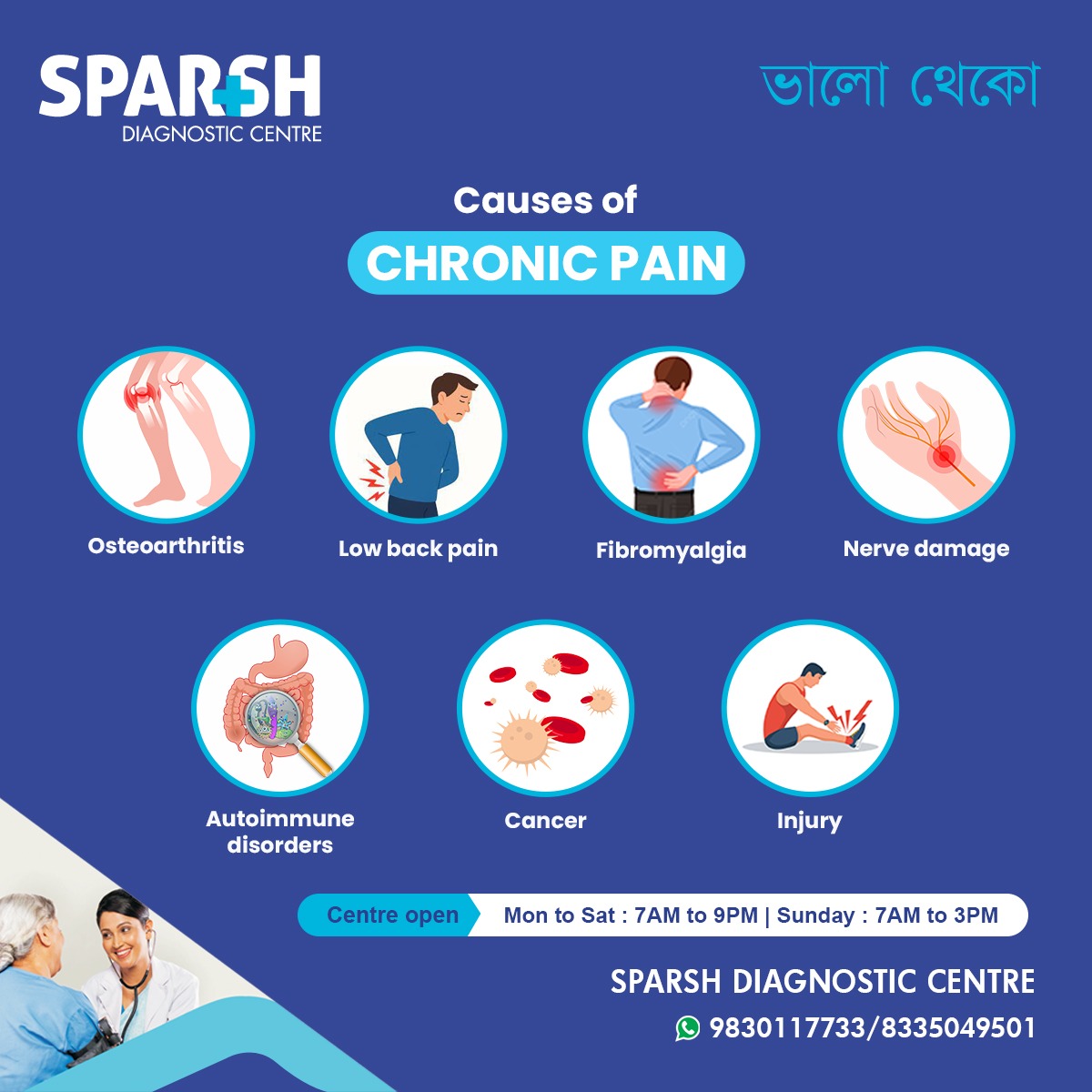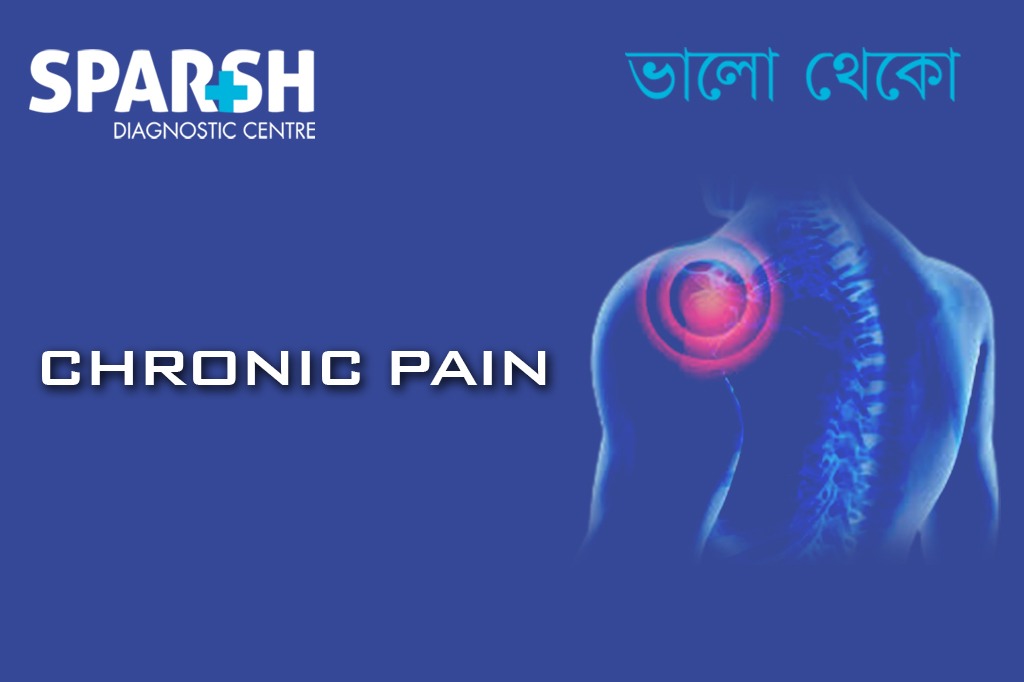Pain is the body’s natural alarm system—a signal that something is wrong. While most pain fades as the underlying cause heals, some pain persists for months or even years. This persistent discomfort is known as chronic pain, a complex condition that can significantly affect physical health, mental well-being, and quality of life.
It is not just a symptom; it’s often a disease in itself. According to global health data, nearly 1 in 5 adults suffer from chronic pain, making it a major public health concern. Understanding its underlying causes and proper management is crucial for effective relief and recovery.
What Is Chronic Pain?
It is defined as pain lasting longer than 3 to 6 months, or beyond the expected healing time of an injury or illness. It can be constant or intermittent, dull or sharp, localized or widespread. Unlike acute pain—which alerts the body to immediate harm—chronic pain persists, even when there’s no ongoing injury.
This type of pain may originate from damaged tissues, nerve dysfunction, inflammation, or even psychological factors. Over time, it can lead to fatigue, anxiety, depression, and impaired mobility.
Common Causes of Chronic Pain
Some of the main causes of chronic pain are:
1. Osteoarthritis
Osteoarthritis is the most common type of arthritis, caused by the gradual wear and tear of joint cartilage. As cartilage breaks down, bones rub against each other, leading to stiffness, swelling, and chronic joint pain—especially in the knees, hips, and hands.
Symptoms include:
Joint stiffness after rest
Swelling and tenderness
Decreased range of motion
Diagnosis: X-rays and MRI scans can reveal cartilage loss and joint damage.
Treatment: Physical therapy, anti-inflammatory medications, joint injections, and in severe cases, joint replacement surgery.
2. Low Back Pain
Chronic low back pain can result from poor posture, muscle strain, herniated discs, spinal stenosis, or degenerative spine diseases. It’s one of the leading causes of disability worldwide.
Common signs:
Persistent pain in the lower back
Stiffness and limited mobility
Diagnosis: MRI or CT scans help detect spinal abnormalities or nerve compression.
Treatment: Exercise therapy, ergonomic corrections, pain relievers, and physiotherapy.
3. Fibromyalgia
Fibromyalgia is a chronic disorder characterized by widespread musculoskeletal pain, fatigue, sleep disturbances, and memory issues. It is believed to involve abnormal pain processing in the brain and nervous system.
Symptoms include:
Widespread pain for over 3 months
Morning stiffness
Sleep problems and fatigue
Diagnosis: Based on medical history, symptom patterns, and physical examination.
Treatment: Regular exercise, stress reduction, medications (like antidepressants or anticonvulsants), and cognitive-behavioral therapy.
4. Nerve Damage (Neuropathic Pain)
Nerve damage or neuropathy can result from diabetes, infections, injuries, or chemotherapy. It causes sharp, burning, or tingling pain that persists long after the initial injury.
Common causes:
Post-herpetic neuralgia (after shingles)
Traumatic nerve injuries
Diagnosis: Nerve conduction studies and electromyography (EMG).
Treatment: Anticonvulsants, antidepressants, nerve blocks, and physical therapy.
5. Autoimmune Disorders
Autoimmune conditions like rheumatoid arthritis, lupus, and multiple sclerosis trigger the immune system to attack healthy tissues, leading to inflammation and chronic pain.
Symptoms include:
Joint pain and swelling
Muscle weakness
Fatigue and stiffness
Diagnosis: Blood tests (ANA, rheumatoid factor) and imaging tests.
Treatment: Immunosuppressants, corticosteroids, and lifestyle modifications.
6. Cancer-Related Pain
Cancer can cause chronic pain due to tumor growth pressing on nerves, bones, or organs. Pain may also arise from treatments like surgery, radiation, or chemotherapy.
Types of cancer pain:
Bone pain from metastasis
Nerve pain from tumor pressure
Treatment-induced neuropathy
Management: Opioid analgesics, nerve blocks, radiation therapy, and palliative care support.
7. Injury
Old injuries—such as fractures, ligament tears, or surgical scars—can sometimes lead to persistent pain, especially if nerve damage or inflammation occurs during healing.
Diagnosis: Imaging (X-rays, MRI) and physical examination.
Treatment: Physical rehabilitation, pain medication, and in some cases, interventional procedures like steroid injections.

Symptoms of Chronic Pain
Chronic pain can manifest in many ways depending on its cause and severity. Common symptoms include:
Constant or intermittent pain
Fatigue and sleep disturbances
Mood changes (anxiety, depression)
Muscle stiffness and reduced flexibility
Decreased appetite or weight changes
How Is Chronic Pain Diagnosed?
Proper diagnosis involves a detailed medical evaluation to identify underlying causes and rule out other conditions.
Diagnostic steps include:
Medical history: Duration, location, and nature of pain.
Physical examination: Checking for tenderness, inflammation, or limited motion.
Imaging tests: X-rays, MRI, or CT scans.
Blood tests: To detect autoimmune or inflammatory disorders.
Nerve studies: EMG or nerve conduction tests for neuropathy.
At Sparsh Diagnostic Centre, advanced imaging and laboratory tests help identify the root cause of chronic pain, ensuring accurate diagnosis and targeted treatment.
Treatment and Management of Chronic Pain
The goal of treatment is to reduce pain intensity, improve function, and enhance quality of life. Chronic pain often requires a multidisciplinary approach.
1. Medications
Nonsteroidal anti-inflammatory drugs (NSAIDs) for pain relief
Antidepressants to manage neuropathic pain
Anticonvulsants for nerve-related discomfort
Opioids (only for severe cases under medical supervision)
Topical creams with lidocaine or capsaicin
2. Physical Therapy
Customized exercise plans strengthen muscles, improve flexibility, and reduce stiffness. Therapies like hydrotherapy, stretching, and massage can be highly effective.
3. Psychological Therapy
Chronic pain affects mental health. Cognitive Behavioral Therapy (CBT) helps patients cope better by addressing emotional responses to pain.
4. Lifestyle Modifications
Maintain a healthy weight
Practice good posture
Engage in regular physical activity
Get adequate sleep
Avoid smoking and excessive alcohol consumption
5. Alternative Therapies
Acupuncture stimulates nerves and boosts natural painkillers
Yoga and meditation reduce stress and tension
Chiropractic care aligns joints and relieves pressure
6. Interventional Treatments
In resistant cases, doctors may recommend:
Nerve blocks or epidural injections
Radiofrequency ablation
Spinal cord stimulation
7. Pain Management Clinics
Specialized centers like Sparsh Diagnostic Centre offer a comprehensive pain management program that includes diagnostic imaging, physiotherapy, and counseling to address both physical and psychological aspects of pain.
Complications of untreated Chronic Pain
Ignoring chronic pain can lead to:
Sleep deprivation
Depression and anxiety
Decreased mobility
Dependence on pain medications
Social withdrawal
Early diagnosis and treatment are key to preventing these complications and maintaining a good quality of life.
Living with Chronic Pain: Coping Tips
Stay active: Gentle movement keeps joints flexible.
Track your pain: Maintain a pain diary to identify triggers.
Seek support: Join chronic pain support groups.
Use relaxation techniques: Deep breathing and mindfulness can reduce pain perception.
Follow up regularly: Regular check-ups ensure effective management.
When to See a Doctor for Chronic Pain
Consult a doctor if:
Pain persists beyond 3 months
You experience weakness, numbness, or loss of function
Over-the-counter medications no longer work
Pain interferes with daily life or sleep
Sparsh Diagnostic Centre provides advanced diagnostic imaging and expert consultation to help determine the underlying cause and develop a personalized pain management plan.
Frequently asked questions (FAQ) on Chronic Pain
1. What is the difference between acute and chronic pain?
Acute pain is temporary and occurs due to injury or illness, resolving with healing. Chronic pain persists beyond 3 months and often continues even after recovery.
2. Can it be cured?
In many cases, chronic pain cannot be completely cured but can be effectively managed through medication, therapy, and lifestyle adjustments.
3. Does stress make it worse?
Yes. Stress increases muscle tension and alters pain perception, intensifying symptoms.
4. What are the best home remedies for it?
Gentle stretching, hot/cold compresses, meditation, and maintaining good posture can help alleviate symptoms.
5. Can diet affect it?
Absolutely. A diet rich in anti-inflammatory foods—like fruits, vegetables, fish, and nuts—can reduce inflammation and pain intensity.
6. How can Sparsh Diagnostic Centre help manage chronic pain?
Sparsh offers diagnostic imaging, lab tests, and expert consultations to identify the cause of pain and recommend tailored treatment options, including physiotherapy and medical management.
Chronic pain is a long-term condition that requires a holistic approach—combining medical care, lifestyle management, and emotional support. While it can be challenging, early diagnosis and personalized treatment can make a tremendous difference.
If you’re struggling with persistent pain, don’t ignore it. Visit Sparsh Diagnostic Centre for accurate diagnosis and comprehensive pain management solutions.
#BhaloTheko
Disclaimer:
No content on this site, regardless of date, should ever be used as a substitute for direct medical advice from your doctor or other qualified clinician.

![]()






[…] Chronic pain […]
[…] Chronic pain […]
[…] Chronic pain […]
[…] Early detection helps prevent complications such as anemia and chronic pain. […]
[…] Chronic pain from spine or hip fractures […]
[…] Chronic pain: Heat is excellent for long-term conditions like arthritis and fibromyalgia. […]
[…] is a chronic pain condition that manifests as widespread musculoskeletal pain, often accompanied by other symptoms […]
[…] causes muscle tension, particularly in the neck, shoulders, and back. This tension can lead to chronic pain and discomfort, affecting posture and mobility. In severe cases, stress can contribute to […]
[…] patients recover fully. Recognizing the symptoms early and seeking professional help can prevent chronic pain and long-term nerve […]
[…] if left untreated, the condition can lead to more severe problems such as abscess formation, chronic pain, or even infertility. Therefore, early detection and treatment are key to a full […]
[…] Therapy and Exercise: For chronic pain conditions, physical therapy and exercise can help improve mobility and reduce pain without the need for […]
[…] while magnesium helps muscles relax. A lack of Mg can lead to muscle cramps, twitches, and even chronic pain. Additionally, it helps regulate nerve transmission, promoting calmness, relaxation, and reducing […]
[…] after an injury. Heat therapy can help relax muscles and improve blood flow, which may alleviate chronic pain or […]
[…] Chronic pain and swelling […]
[…] lose elasticity and height, and joints may develop osteoarthritis. This age-related wear can cause chronic pain and […]